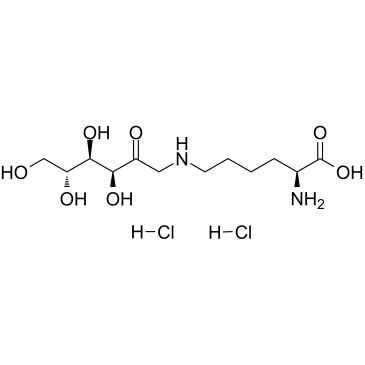96192-35-7
| Name | ε-N-Deoxyfructosyllysine dihydrochloride |
|---|
| Description | Fructosyl-lysine (Fructoselysine) dihydrochloride is an amadori glycation product from the reaction of glucose and lysine by the Maillard reaction. Fructosyl-lysine dihydrochloride is the precursor to glucosepane, a lysine–arginine protein cross-link that can be an indicator in diabetes detection[1]. |
|---|---|
| Related Catalog | |
| Target |
IC50: precursor to glucosepane[2] |
| In Vitro | Fructosyl-lysine dihydrochloride (5 mM; 0.5 hours) catalyzes the ATP-dependent conversion of [14C]fructoselysine to anionic products suggesting the existence of a fructoselysine-kinase activity in E .coli extracts[2]. Fructosyl-lysine dihydrochloride (100 μM; 1 hour) contains a carbohydrate moiety and appears to be phosphorylated, it can be converted to glucose 6-phosphate in bacterial extracts in E .coli extracts[2]. Fructosyl-lysine dihydrochloride (25 mM; 25 hours) lets E. coli growth at a rate of about one-third of that observed with glucose as a carbon source. Lysine itself does not support growth in the absence of other carbon source and does not affect the growth observed with glucose[2]. |
| In Vivo | Fructosyl-lysine dihydrochloride and AGE residues is increased markedly in glomeruli, retina, sciatic nerve, and plasma protein in diabetic rats[1]. |
| References |
| No Any Chemical & Physical Properties |
